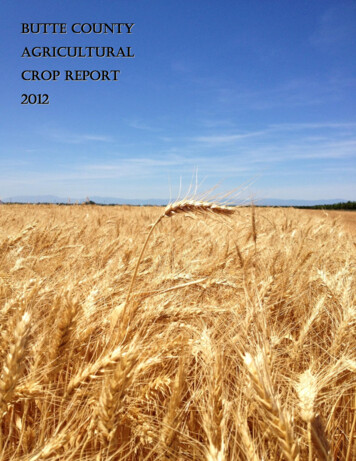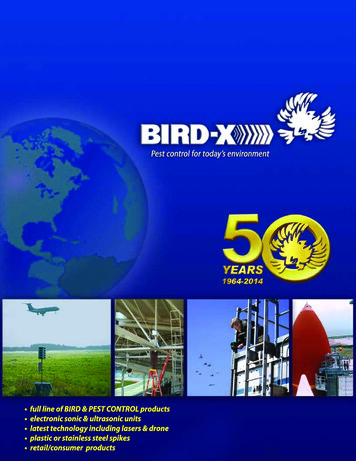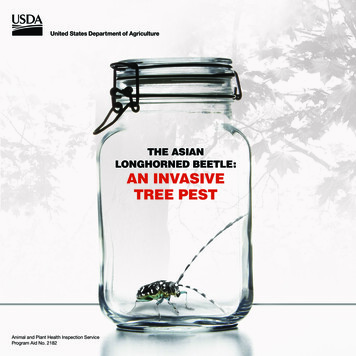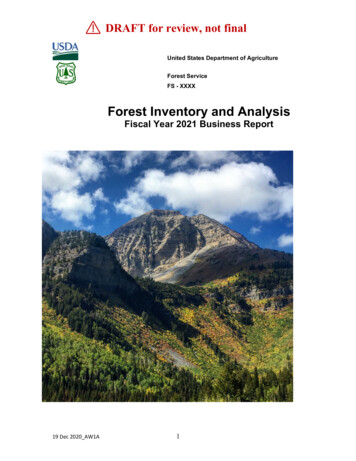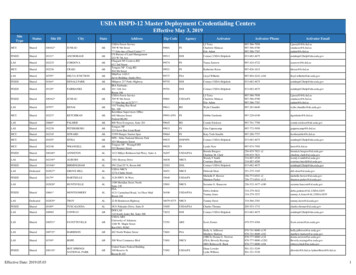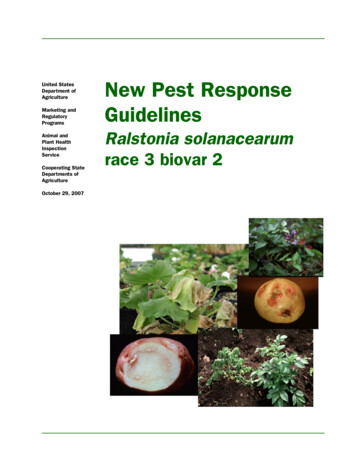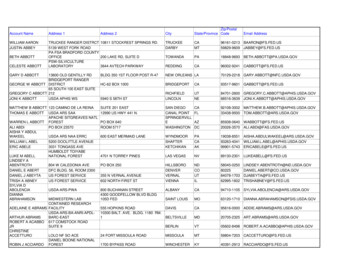
Transcription
U.S. Department of AgricultureAnimal & Plant Health Inspection ServiceWildlife ServicesAugust 2016Wildlife Damage ManagementTechnical SeriesGeese, Ducks andCootsJohn CummingsCertified Wildlife Biologist/RetiredResearch Wildlife BiologistUSDA-APHIS-Wildlife ServicesNational Wildlife Research CenterFort Collins, ColoradoFigure 1. Canada geese (Branta candensis).Human-Wildlife ConflictsLandscapesQuick LinksHuman-Wildlife Conflicts1Damage Identification3Management Methods3Economics11Species Overview12Legal Status17Glossary & Key Words18Resources19Appendices21Canada geese, snow geese, ducks, andAmerican coots all have been implicated inagricultural crop and turf damage.Canada geese and snow geese that grazeon winter wheat and rye crops can reducesubsequent grain and vegetative yields.Canada geese also cause serious damageto sprouting soybeans in spring and tostanding cornfields in the autumn. Themost common damage to agriculturalresources associated with geese resultsfrom consumption of crops. Other impactsinvolve unacceptable accumulations offeces in pastures, trampling of emergingcrops, and increased erosion and runofffrom fields where the cover crop has beengrazed. Canada geese graze on a variety ofcrops, including alfalfa, barley, beans,corn, soybeans, wheat, rye, oats, spinach,and peanuts, sometimes resulting insignificant reductions in yields.Since the dramatic increase in snow goosepopulations, there has been extensivedamage to their breeding habitat in the
Page 2WDM Technical Series—Geese, Ducks and Cootsthese locations varies by species, numbers, andconcentrations, but can be substantial. For example,damage to putting greens by geese, ducks, or coots cancost thousands of dollars to repair or replace.Human Health and SafetyFigure 2. Snow goose (Chen caerulescens).in the Arctic and tremendous grazing pressure on exposedcrops and vegetation during the early spring migration.Most damage results from grubbing, trampling, anduprooting and occurs along the migration route on theeastern coastal areas, and in the mid-western andsouthern states. In addition, agricultural producers areconcerned that geese spread noxious seeds to crop andpasture lands and reduce livestock forage.During the fall, winter, and early spring, large flocks ofducks and American coots migrate into California wherethey damage small grains and alfalfa. Most damage isfrom grazing on alfalfa or sprouting grain. In the fall, largeflocks of ducks and American coots alighting in unharvested rice fields trample and consume the crop.Prior to the 1990s, ducks and geese had been reported tocause as much as 6 million to 10 million in damages tograins that are swathed and laid on the ground beforeharvesting. Most of this damage occurred in the CanadianProvinces and Dakotas. However, changes in harvestingtechniques in the 1990s from swathing to straight- orstripper-cutting have greatly resolved the problem.Migratory Canada geese, ducks, and American coots ontheir winter range have become acclimated to urbanenvironments where they graze on domesticated grassesin parks, golf courses, highway rights-of-way, sport fields,and similar locations. Damage and economic costs atOverabundant geese, ducks, and coots also can presenthuman health and safety issues. A single Canada goosecan defecate every 20 minutes, resulting in up to 1.5pounds of feces per bird each day. This problem ismagnified when one considers that populations of residentgeese have increased dramatically to about 3.75 million in2012. The accumulation of bird feces in reservoirs, atparks, on golf courses, or where people gather can presenta health risk. Four hundred samples of feces collected overa 2-year period from Canada geese and ring-billed gulls(Larus delawarensis) contained significant numbers offecal coliform bacteria (FC) per gram. The impact on themicrobiological quality of the water is multiplied wherehundreds or thousands of birds roost on the water surface,especially near intakes to aqueducts.Geese, ducks, and coots present hazards to aircraftdepending on the location, time of year, and habitat on ornear airfields. In 1995 Canada geese caused one of theworst military bird strikes ever recorded when a E-3 AWACSaircraft struck a flock of geese on take-off at Elmendorf AirForce Base in Alaska, resulting in total destruction of theaircraft and the loss of all 24 crew members. In 2009, USAirways Flight 1549 taking off from John F. KennedyInternational Airport ingested Canada geese at 3,000 feetabove ground level, destroying both engines. Fortunately,the crew safely landed the airplane in the Hudson Riverand evacuated all passengers.On November 8, 2000, a Saab 340 Turbo-prop planelanding at Aberdeen, South Dakota, flew through a flock of200 snow geese at 600 feet above ground level. Onegoose hit the windscreen and dislodged the wiper arm,which then hit the propeller. The propeller then threw thewiper arm parts into the fuselage at three locations,causing more serious damage. One piece of the wiper armcame through the fuselage and embedded in the thigh of apassenger.
Page 3U.S. Department of AgricultureDamage IdentificationGenerally, goose, duck, and American coot damage tocrops, vegetation and aircraft can be difficult to identify.Usually the damage to crops or vegetation shows signs ofbeing clipped, torn, or stripped (Figures 3,4). Tracks, feces,or feathers found neat the damage can be used to helpidentify the species. Damage to aircraft is obvious if thebird is recovered, but if not, and only bird parts are recovered, a scientific analysis is required.Management MethodsFigure 4. Damage to newly planted wheat by Canada geese.Auditory Frightening DevicesGas-Operated CannonsGas-operated cannons, generally referred to as propanecannons, are commonly used to disperse geese, waterfowl,and coots from a number of locations, including agricultural crops, wastewater ponds, and airfields (Figure 5). Thesedevices produce loud (120-decibel [dB]), intermittent explosions at 1- to 30-minute intervals, and are effective onareas up to 120 acres. New versions emit up to three explosions in rapid succession and in various directions.Figure 3. Goose, duck and coot damage to crops or vegetation typicallyinvolves plants being clipped, pulled and trampled. Feces left behind cancarry noxious weed seeds.Some units allow for remote activation. Although more expensive, these units reduce habituation because they areactivated remotely by people only when birds are present.Propane cannons used to disperse waterbirds at Naval AirStation North Island and Naval Outlying Landing Field Imperial Beach, California, have worked when the cannonswere moved every 2 to 3 days and supplemented with other hazing tools. The effectiveness of propane cannons todeter molting sea ducks, mostly long-tailed ducks(Clangula hyemalis), was tested in the Beaufort Sea. Thecannon was mounted on a raft anchored in the center ofan experimental plot and operated at a volume of approximately 120 dB, and at a firing interval of approximately 5minutes. On the first day of operation, the scaring radiusfor sitting birds was 3,000 feet. The number of birds remaining within 3,000 feet of the cannon was less than10% of the original number present. That scaring radiusdecreased to 1,800 feet by the second day and the densityof birds increased. By the third day, the number of birds inthe general area increased to a level higher than the average numbers present during control periods, indicating theeffectiveness of the cannon significantly decreased.In another study in coastal areas near Vancouver, BritishColumbia, a propane cannon was anchored on a raft in anintertidal zone, and another in a drifting boat in open waterhabitat. The propane cannons were usually set for one
Page 4WDM Technical Series—Geese, Ducks and CootsPyrotechnicsFigure 5. Gas-operated cannons, generally referred to as propane cannons,are commonly used to disperse geese, waterfowl, and coots.explosion every 20 to 25 minutes. The firing interval wasdecreased to one every 5 minutes. Explosions wereapproximately 125 dB at 600 feet from the source overwater under optimum conditions. The raft-mountedpropane cannon kept all waterfowl away up to a 600-footradius. It was especially effective on mallards, pintails, teal,and widgeon.The propane cannon also effectively dispersed waterfowlfeeding at night, and it appeared that the effective rangewas at least the same at night as in daylight. The responsedistance to the propane cannon for the 31 species ofwaterbirds recorded varied from 30 to 750 feet.Habituation was observed in most of the major groups ofwaterbirds tested. Some bird species, such as the northernshoveler (Anas clypeata) and teal (Anas spp.) becametolerant to blasts after 4 hours of continuous firing. Theestimated cost of a typical propane cannon such as theZon Standard, single-fire propane cannon, is 240. TheZon Electra, a multiple-fire propane cannon, is 650.The advantages of propane cannons are that they areportable, effective day or night, are inexpensive to operate,and are especially effective in deterring dabbling ducksand geese. Disadvantages are that they must be movedevery 2 to 3 days to prevent habituation, regularmaintenance is required, they have limited effectivenesson American coots, and the explosions may be a nuisanceto nearby residents.Pyrotechnics include various devices fired from shotguns,starter pistols, and flare pistols, or specialized launchers(Figure 6). Pyrotechnics include banger/whistler cartridges,shell crackers, flares, firecrackers, cartouche anti perilaviaire (CAPA) cartridges, and rockets, that produce a loudblast or scream accompanied by smoke and a flash oflight. The most common pyrotechnics used for birddispersal are 15-millimeter (mm) bangers, 15-mmwhistlers, 12-gauge shell crackers, and 18-mm CAPAcartridges. Pyrotechnics travel 75 to 900 feet beforeemitting a blast, flash, or bright light. Some emit ascreaming or whistling sound during flight. The 15-mmbangers and whistlers have a range of approximately 150to 200 feet. The 12-gauge shell crackers have a range ofapproximately 200 to 300 feet. The 18-mm CAPA cartridgehas the greatest range, shooting an exploding rocket to adistance of 1,000 feet with a report of approximately 150dB. Operators should wear eye and ear protection at alltimes. Pyrotechnics can be very useful in hazing birds in avariety of situations, when used in combination with otherhazing techniques.For safety reasons, only trained personnel should firepyrotechnics. The launching device should be an openchoked, single-shot, 12-gauge shotgun (for shell crackers)or a pyrotechnics pistol (for bangers and whistlers) thatFigure 6. a) 15mm pistol, banger (red) and whistler (yellow) cartridges, (b)18mm CAPA pistol and cartridge, (c) shotgun used to launch 12-guage shellcrackers, (d) firing a pyrotechnic device.
Page 5U.S. Department of Agricultureallow for easy inspection of the barrel. Other safetyprecautions that should be taken in any program usingpyrotechnics include the following: operators should wear eye and ear protection at alltimescheck gun barrels for obstructions after each firing asshell crackers may misfireclean guns each day after use, as shell crackers arecorrosivepyrotechnics must be fired from pyrotechnics pistolsonlytake necessary fire precautions, as pyrotechnics canbe a fire hazarddo not fire pyrotechnics from inside a vehicleIf used correctly, pyrotechnics provide one of the mosteffective methods to disperse geese, waterfowl, andAmerican coots from crops and open water. Pyrotechnicscan effectively haze waterfowl at distances up to 3,000feet. They are effective day or night and are relativelyinexpensive. The disadvantages of pyrotechnics are theycan be labor intensive, geese, waterfowl, or American cootsmay habituate to them, especially if they are usedimproperly (used too frequently). There is some degree offire hazard associate with these devices when used duringdry conditions, and they may be a nuisance to people livingnearby.Visual Frightening DevicesVisual dispersal techniques include hawk kites, hawksilhouettes, lights, eyespot balloons, flags, Mylar reflective tape, effigies, scarecrows (human or predator),and lasers. Most of these devices are effective for a shortperiod before birds become habituated to them becausethey learn that the devices pose no danger. Geese andwaterfowl seem to respond to some of these devices morethan others, especially during hunting seasons.FlaggingWhite flags and black flags made from 30-inch x 60-inchgarbage bags have been shown to significantly andeffectively deter snow geese from agricultural fields. FlagsFigure 7. Avian Dissuader laser for dispersing birds.are typically placed on 4-foot stakes at one flag per acre.Cost of each flag and stake is about 0.30.LasersLasers have shown promise for dispersing some waterfowl,geese, cormorants, and other waterbird species (Figure 7).Lasers are most effective before dawn or after dusk, whenred or green beams are clearly visible. Bright sunlight willwash out a laser beam, rendering it ineffective, but thegreen beam is most visible in brighter situations. Althoughbird vision differs from that of humans, a laser beam isvisible to some species and results in the birds dispersing.The effectiveness of low-powered lasers varies with thebird species and the context of the application, likely dueto differences in eye structure among bird species.The US Food and Drug Administration (FDA) regulates laserdevices because of safety concerns due to radiationemissions and potential tissue damage. The FDA standardfor unregulated lasers is generally less than 5.0 milliwatts(mW) of power. Lasers using more than 5.0 mW of powerrequire a variance (permit) from FDA.Canada goose numbers were successfully reduced by 85%at sites used consistently for foraging, loafing, androosting. The reduction followed a 5-day treatment periodwhere geese at each site were hazed for a 30-minuteperiod each night. The Avian Dissuader red laser was usedat night to disperse waterfowl (Anatidae spp.), herons
Page 6WDM Technical Series—Geese, Ducks and Cootsactivating the laser when bird activity is detected. Thesystem is powered by a 12-volt gel battery, but can beconverted to solar power or a marine battery. The batterylife depends on use; a marine battery operating at 12hours per day could keep the system functioning for 4 to 5days. The laser is considered non-harmful to humans.Figure 8. Coyote models or decoys are used to deter geese and otherwaterfowl.(Ardeidae spp.), and egrets (Ardeidae spp.) from wetlands.Roosting flocks of waterfowl, herons, and egrets weredispersed to other areas after repeated hazing for lessthan 30 minutes. Monitoring on following nights indicatedthat none of the hazed species returned to their originalroosting areas. The estimated cost of the Avian Dissuaderis 1,400- 2,000 per unit. Advantages of the laser is thatit can be used to disperse birds from long distances(effective up to 2,600 feet), is effective on most birdspecies, (especially waterfowl), is easy to operate, requiresminimal training, and is considered safe when usedproperly. The disadvantages are that it is only effective atnight and dusk, and not effective on all bird species.Avian Systems Corporation (ASC) 7500 Rotating LaserSystemThe Avian Systems Corporation (ASC) 7500 Rotating LaserSystem is a stationary device that can be mounted on astand on land or in water. The relatively compact unit canbe transported easily to different locations. The unit has adrive system for a low-intensity laser beam that can beprogrammed to scan 360 degrees and also up or down, asneeded. The laser beam also can be programmed to stopor reverse field, or be used in a random mode. The laserbeam is either red or green, and approximately 3 inches indiameter. The operational distance for the beam is up to1,500 feet. The unit can be set to operate at designatedtimes, or a radar system can be integrated with the system,The effectiveness of the ASC 7500 was tested on Canadageese at several nighttime roosting sites near small golfcourse water impoundments, using an on-off test design(ASC personal communication). After one night of laseroperation, geese dispersed to other locations. After theunit was removed, geese reestablished within 48 hours.The unit was effective over a multiple-week test period. Nohabituation to the laser unit was observed. In anotherstudy conducted under a controlled situation in large pens,a motion-detection device activated the laser unit whengeese entered the treated area. The unit reduced Canadagoose use of a treated roosting area by 83% to 92% during20 nights of operation.The ASC 7500 was evaluated on a 320-acre pond. Thesystem was effective in flushing and moving dabblingducks at approximately 1,000 feet, but had no effect atlonger distances. There was no effect on diving ducks,such as coots, at ranges over 100 feet (J. Cummings,unpublished data).The estimated cost of the ASC 7500 system without radaris 5,000- 7,000 per unit. This system uses low power,rotates, and can disperse birds at long distances. It useseither red or green lasers, which increases itseffectiveness, especially on waterfowl. The beam is 3inches in diameter. The disadvantages are that the systemis expensive and effective only at night. It is not effectiveon all birds, such as diving ducks, and there could bepower issues when operating for prolonged periods.Coyote Predator ModelsCoyote models (Figure 8) have successfully deterredgeese, waterfowl, and coots from using agriculture cropsand areas on airfields. The more realistic the coyotepredator model, the more effective it is in dispersing birds.As for any device, habitation can occur, so moving the
Page 7U.S. Department of Agriculturecoyote predator model will extend its effectiveness. Thesedevices are relatively inexpensive, about 100 per model,and associated labor costs are low. Coyote modelssometimes attract rather than repel birds, a potential issueespecially on airfields.Auditory-Visual Frightening DevicesRadio-Controlled Model Aircraft, Helicopters and BoatsRadio-controlled model aircraft, helicopters, and boatsprovide both visual and auditory cues, and have shownvarying degrees of success. The effectiveness of radiocontrolled devices depends on the level of operatorexperience.Radio-controlled boats combine two key features for hazingbirds: a visual and auditory (engine noise) stimulus. Radiocontrolled boats require little experience to operate andcan cover the area within 1,000 feet of the operator, orabout 35 acres. These boats have been shown tosuccessfully haze waterfowl from ponds and lakes.Gas-powered, radio-controlled helicopters were usedsuccessfully at the Reno Airport to move Canada geese.Geese did not habituate to the helicopter, and in mostcases, dispersed upon the start of the engine. Operators ofthese devices should ensure that the radio frequencies arecompatible with other electronics in the area. Theestimated cost is about 1,000 per unit, includingperipherals.When properly equipped, these devices are an inexpensiveway to disperse a wide range of species at long distanceswith precision. They can be used during the day or night.Some skill is required to operate and maintain the devices.DogsUsing dogs to harass geese from an area has become apopular and successful method. Highly trained bordercollies generally are used but just about any athletic,medium-large dog capable of obeying commands can beeffective in hazing geese, waterfowl, and coots. Control ofthe dog is vital because dogs used in this manner arelegally considered an extension of your hand and must notbe allowed to catch, injure, or kill Canada geese, waterfowl,or coots.Typically, a handler and a dog will enter an area occupiedby unwanted geese, waterfowl, or coots. On command, thedog is allowed to chase after the birds. Generally, birds willseek refuge from the dog in a nearby body of water. If thisis the case, let the dog enter the water. To make thismethod more effective, use a boat or pyrotechnics tofurther harass the birds. Harassment should continue andbe repeated until the birds leave the area permanently.Consult with the U.S. Fish and Wildlife Service (USFWS),state, and local agencies regarding authorization andpermits for use of dogs to haze geese, waterfowl andcoots.RepellentsAnthraquinone and methyl anthranilate are two chemicalcompounds registered as bird repellents with the U.S.Environmental Protection Agency (EPA). These compoundsare sold under several product names for use in variousagriculture, airfield, and urban situations.Anthraquinone (AQ) is a naturally-occurring compoundfound in many plant species, and was first patented in1944 as a bird repellent. The mechanism of repellency forAQ is not well understood. Ingestion of AQ-treated food bybirds can produce vomiting, presumably through irritationof the gut lining.Two AQ products, Flight Control Plus and Avipel areregistered with EPA. Flight Control Plus can be used in allstates except California. It is generally applied on turf orgrass areas used by geese, specifically Canada geese. Itcannot be used on food crops. Avipel has two productlabels, one for use as a goose repellent similar to FlightControl Plus and the other as a product designed toprotect newly-planted seed from birds.Methyl anthranilate is a compound derived from concordgrapes, approved for human consumption by the FDA, andhas been found to be offensive to birds. It produces anegative response in most birds by affecting the trigeminalreceptors in the mouth.
Page 8Several methyl anthranilate products are registered withEPA as bird repellents for geese, waterfowl, and coots.Products include Rejex-it Migrate , Rejex-it Fog Force (TP-40), Liquid Fence Goose Repellent , and Bird Shield .The mode of action is similar among products, butformulations, concentrations, and application rates vary.Repellents can be costly, due to the large quantitiesneeded to be effective, and the need to reapply afterperiods of precipitation. Frequent reapplication on cropsand/or turf-grass areas is necessary to ensure adequatecoverage during the growing season, especially in turfareas where the turf is mowed. Cost for Rejex-it Migrate isapproximately 600 per acre, Flight Control Plus isapproximately 200 per acre, and Avipel is approximately 10 per acre of treated seed.Nest Removal and TreatmentNest removal and treatment of eggs generally is authorizedby USFWS for resident or non-migratory Canada geesethrough a permit. Consult with the USFWS regardingauthorization and permits for special situations concerningmigratory geese, waterfowl, and coots.Nest treatment usually involves manipulating eggs so theydo not develop. Methods include addling (shaking), oilingwith corn oil (Figure 9), puncturing, chilling, and replacingeggs. Returning treated eggs to the nest encourages adultbirds to remain on the nest beyond the expected hatchingdate, which reduces or prevents the potential for renesting.WDM Technical Series—Geese, Ducks and Cootsgeese, waterfowl, and coots. Consult with the USFWSregarding authorization and permits for special situationconcerning migratory geese, waterfowl and coots.ShootingHunting is the primary method for managing Canadagoose, waterfowl, and coot populations. Hunting can havean area-deterrent effect on these species, but hunters arerestricted to established bag limits. Shooting permitsoutside of regulated hunting seasons may often beobtained by USFWS for migratory, resident or non-migratoryCanada geese, waterfowl, and coots. This method cansolve very localized problems.Habitat ModificationPonds, lakes and sloughs adjacent to agricultural areasand airfields can attract large numbers of geese,waterfowl, and coots for foraging, nesting, loafing, andresting. Changing the adjacent habitat at these sites canhelp to reduce bird use. However, these species are veryadaptable and habitat changes in a rural setting can beenvironmentally challenging. Federal and state laws governdraining or channelizing wetlands, ponds, or lakes andintroducing less attractive vegetation might not becompatible with current water and farming practices orairfield maintenance.Habitat modification is better suited for suburban andurban areas such as parks, golf courses, residential areas,and airports. Consider the following when modifyinghabitat for geese, waterfowl, and coots.Fertility Control Install vertical, sight-limiting components, such astrees, shrubs, or aquatic vegetation (cattails). This candisrupt an unobstructed line of sight and help deterthem from grazing or walking readily from the watersource. Limit and reduce the palatability of adjacent habitat byavoiding planting preferred foods such as succulentgrasses. Maintain grass height at 8 or more inches. Plant water lilies or other non-invasive emergentNone is available.ToxicantsNone are available.Trapping and RelocationTrapping and relocation generally is authorized by permitfrom the USFWS for resident or non-migratory Canada
U.S. Department of Agricultureaquatic vegetation to prevent waterfowl movementand use on the pond or lakes. In colder climates, turn off water aerators in ponds,and allow the water to freeze. In some cases, plant a lure crop to attract birds awayfrom where they are not wanted. Remove and modify nest sites such as platforms,structures, and other waterfowl nest supports.Page 9less attractive. Delaying planting until after most migratorybirds have departed the area can reduce damage.Historically, geese and waterfowl have caused severedamage to swath grains, although advances in breedingprograms for cereal crops now allow most grain crops to bestraight-combined, alleviating swathing. Where swathingand migratory waterfowl overlap, birds will cause damagethrough direct consumption, contamination by feces, andtrampling swaths. Waterfowl trample as much as five timesmore grain than they consume. One Canadian researcherestimated Canadian prairie-wide losses of 6 to 10million annually, mainly from waterfowl.Cultural ControlWaterfowl damage to agricultural crops typically occursduring spring planting and fall harvest. A small number ofgeese, waterfowl, or coots can cause damage during postplanting periods to a variety of crops, such as corn,soybeans, and small grains. In rice crops, laser-leveledfields require less water height for planting, making fieldsDiversionary feeding with lure or decoy crops has provensuccessful for controlling crop depredations. Twoapproaches can be used: (1) grow or purchase lure cropswhere geese, waterfowl, or coots can feed unmolested andaway from other commercial crops, or (2) use bait stationsor field baiting for the same purpose. These programs havebeen used on and near wildlife refuges and waterfowlmanagement areas that provide protection, food, water,and cover; and help to keep birds onsite while crops aresusceptible to damage.Currently, one of the most common methods to reduce useof airfields by geese, waterfowl, and coots is to maintainvegetation height at 7 to 14 inches. Long grass restrictsthe line of sight for birds, making them vulnerable andnervous about unseen predators. In some cases, however,long-grass management attracts other granivorous birdsthat may move onto runways. An alternative approach is toestablish less preferred vegetation that is unpalatable togeese, waterfowl, and coots and has minimal seedproduction. In addition to requiring little maintenance, thevegetation also should be relatively non-flammable,drought resistant, unattractive to invertebrates androdents, and exclude the establishment of other plants.Figure 9. Oiling goose eggs with corn oil prevents them from developing andreduces the potential for re-nesting.
Page 10WDM Technical Series—Geese, Ducks and CootsStructural ModificationNetsDiscourage geese, waterfowl, and coots from using existingponds by straightening the banks vertically up to 30inches. Placing large boulders or rip-rap along the edge ofa pond makes it more difficult, but not impossible for thesebirds to enter and exit the water.Nets are not economical for most agricultural crops wheregeese, waterfowl, or coots are involved, but can be used tocover ponds on airfields.ExclusionFencingBarrier and energized fencing can help keep geese,waterfowl, and coots out of agriculture crops and areas onairfields where they have walking access, especially duringthe molting season. Construct barrier fences from wovenwire, poultry wire, plastic snow fence, chain link, netting,pickets, or strands of wires. To be effective in thesesituations, barrier fences should be at least 30 inches highand made of durable material with openings no larger than2 to 3 inches.Energized fences with triple-strand wires strung 3, 10, and15 inches above the ground with minimal amperage willexclude birds without harming them. Components of anenergized triple-strand fence are (1) an energizer, eitherbattery powered or 120 volts (low impedance energizerswhich deliver a short electrical pulse of at least 4,000 voltsonce every second are safe and effective); (2) either ½inch wide polyethylene fibers interwoven with conductivewires, or 17-gauge electric fence conductive wire; and (3) agrounding system composed of a series of 6-footgalvanized-steel rods driven into the earth at 12-footintervals for the length of the protected area. The rods areconnected in series with the wire, which is connected tothe ground terminal on the energizer.Geese, waterfowl, or coots that touch an energized fencereceive an uncomfortable but harmless shock that theylearn to avoid.Netting is available in a variety of materials (nylon,polyethylene, polypropylene), mesh sizes (0.5-inch to 10inch), and dimensions. Nets should be resistant toultraviolet (UV) light or coated to make them UV-resistant.With all factors being equal, nylon is the strongest material,followed by polyethyle
Zon Standard, single-fire propane cannon, is 240. The Zon Electra, a multiple-fire propane cannon, is 650. The advantages of propane cannons are that they are portable, effective day or night, are inexpensive to operate, and are especially effective in deterring dabbling ducks and geese. Disadvantages are that they must be moved

